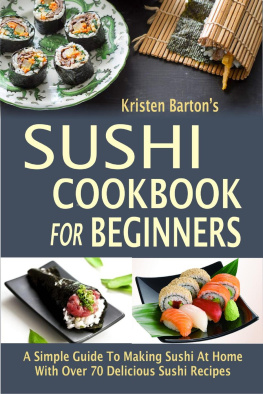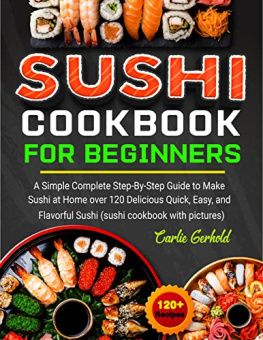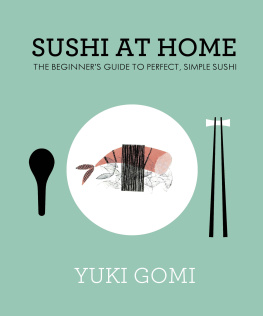SUSHI, SASHIMI AND BENTO
COOKBOOK
70 Easy Recipes For Traditional Japanese Food |

Emma Yang
Copyright 2021 by (Emma Yang) - All rights reserved.
This document is geared towards providing exact and reliable information in regards to the topic and issue covered. The publication is sold with the idea that the publisher is not required to render accounting, officially permitted, or otherwise, qualified services. If advice is necessary, legal or professional, a practiced individual in the profession should be ordered.
- From a Declaration of Principles which was accepted and approved equally by a Committee of the American Bar Association and a Committee of Publishers and Associations.
It is not legal in any way to reproduce, duplicate, or transmit any part of this document in either electronic means or in printed format. Recording of this publication is strictly prohibited and any storage of this document is not allowed unless with written permission from the publisher. All rights reserved.
The information provided herein is stated to be truthful and consistent, in that any liability, in terms of inattention or otherwise, by any usage or abuse of any policies, processes, or directions contained within is the solitary and utter responsibility of the recipient reader. Under no circumstances will any legal responsibility or blame be held against the publisher for any reparation, damages, or monetary loss due to the information herein, either directly or indirectly.
Respective authors own all copyrights not held by the publisher.
The information herein is offered for informational purposes solely, and is universal as so. The presentation of the information is without contract or any type of guarantee assurance.
The trademarks that are used are without any consent, and the publication of the trademark is without permission or backing by the trademark owner. All trademarks and brands within this book are for clarifying purposes only and are the owned by the owners themselves, not affiliated with this document.
Contents
Introduction
Sushi is probably the world's most popular Japanese cuisine. Any meal made with vinegar rice is known as sushi. Many fish are used in sushi dishes, but you cannot produce sushi without using any seafood or fresh fish. Since most part of Japan is exposed to Sea, both seafood and rice have always been commonly eaten. Originally, sushi was preserved fish with rice stored in salt, and this became a standard dish for a thousand years in Japan before the development of modern sushi in the Edo Era. The name "sushi" means "this is sour", representing the roots of sushi being stored in salt.
Sashimi is raw fish that is finely sliced. It is regarded as one of the most well-known dishes in Japanese food. Sashimi is most often associated with fish, although it may also include other proteins (such as cattle, cow, and deer) and other products . With several new styles of sushi and sashimi being developed, they are becoming more and more popular around the world.
In Japanese tradition, Bento boxes are the traditional lunch boxes with sections prepared by Japanese women for their partners and other family members. Initially, they originated as basic meals that needed little to no assembling effort. Currently, they are an internationally common, colorful art form. It is popular in Chinese, Korean, and Taiwanese cuisines beyond Japan and in Southeast Asian foods where the principal food is rice.
Sushi has many health benefits as it has Omega3, which decreases heart and skin diseases. It nourishes the brain and helps fasten your memory. It is suitable for women suffering from osteoporosis. Sushi is good to keep your muscles in a good state. There are many types of sushi, sashimi, and Bento. The most common and famous types are described in the book. "Sushi, Sashimi and Bento Cookbook" has three chapters with all relative and vital information. Different delicious and easy to make recipes have been given in this book consisting of sushi, sashimi, and bento. The first thing you have to do is to start reading the different cooking styles of bento, sashimi, and sushi in this book and increase your sense of taste for real Japanese food.
Chapter 1: Japanese Sushi Recipes
1.1 Chicken Sushi
Cooking Time: 20 minutes
Serving Size:
Ingredients: |
- 1 avocado (chopped)
- 1 small carrot (strips)
- 1 cups of sushi rice
- 1 bamboo sushi mat
- 160g can chicken
- teaspoon salt
- 4 nori sheets
- soy sauce to serve
- 3 tablespoon sushi vinegar
- wasabi to serve
- pickled ginger to serve
|
Method:
- Put the rice in a strainer and thoroughly rinse under cold water.
- Put 2 cups of ice water and a half teaspoon of salt in a frying pan. Just bring it to a boil.
- Allow for twelve minutes and steam. Turn off the heat and let it remain with the lid on for ten minutes.
- Mix the sushi vinegar cautiously and move it to a cooling tray.
- Spread about two handfuls of rice over the Nori with greasy fingers.
- Put shredded chicken with Lite Mayo in the center of the rice and place avocado and vegetable slices on top.
- Use wasabi, pickled ginger, and sesame oil to eat.
1.2 Avocado and Salmon Sushi Rolls
Cooking Time: 1 hour
Serving Size:
Ingredients: |
- 1 medium ripe avocado
- Reduced-sodium soy sauce
- 1 small cucumber
- 3 ounces of imitation crabmeat
- 2 cups sushi rice
- Bamboo sushi mat
- 8 nori sheets
- 2 cups of water
- 2 tablespoons sesame seeds
- 2 tablespoons black sesame seeds
- cup rice vinegar
- teaspoon salt
- 2 tablespoons sugar
|
Method:
- Mix rice and water in a big frying pan and set aside for thirty minutes.
- Bring the water to a boil. Cover and set aside for ten minutes.
- In the meantime, whisk together the vinegar, syrup, sugar and salt in a shallow saucepan until the sugar dissolves.
- Place aside the toasted and black sesame seeds on a tray.
- Put cup rice on a piece of plastic wrap.
- Roll up the rice mixture and place it on top of the filling.
- Remove the mat from the sushi rolls and cover them with sesame seeds.
- To make six rolls, repeat with the remaining components.
- If required, top with soy sauce, miso, and herb slices.
1.3 Rainbow Sushi
Cooking Time: 40 minutes
Serving Size:
Ingredients: |
- 4 tablespoon Rice vinegar
- Agave nectar
- 2 cups of cooked rice
- Sesame seeds
- Hoisin sauce
- 1 Avocado (sliced)
- 12 sheets Nori seaweed
- 1 cup cucumber (Sliced)
- cup carrots (Sliced)
- 1 cup red pepper (Sliced)
- cup or shredded beets (Sliced)
|
Method:
- Thinly slice the veggies or shred them. Optional: With 2-4 tablespoons of rice vinegar and several amounts of agave, spice the cooked rice.
- Place cooked rice on the top of each nori sheet.
- Top with vegetables and avocado, with the spraying of sesame seeds if you like.
- Roll it firmly into a log form and repeat. Break the rolls of Nori into smaller pieces.
- Serve with hoisin sauce.
1.4 Kid-Friendly Sushi Rolls
Cooking Time: 1 hour





![Yang - The latehomecomer: [a Hmong family memoir]](/uploads/posts/book/165016/thumbs/yang-the-latehomecomer-a-hmong-family-memoir.jpg)








